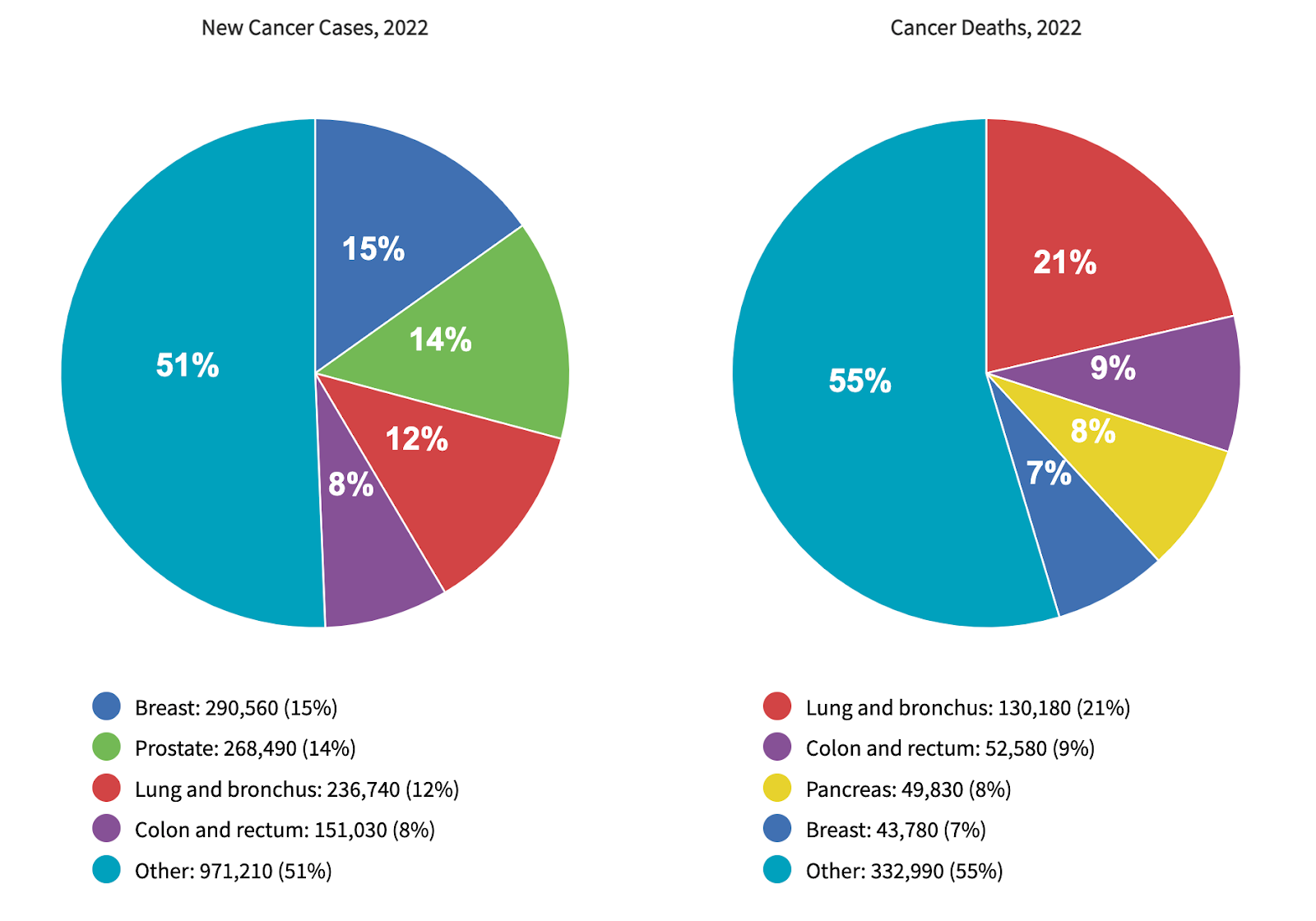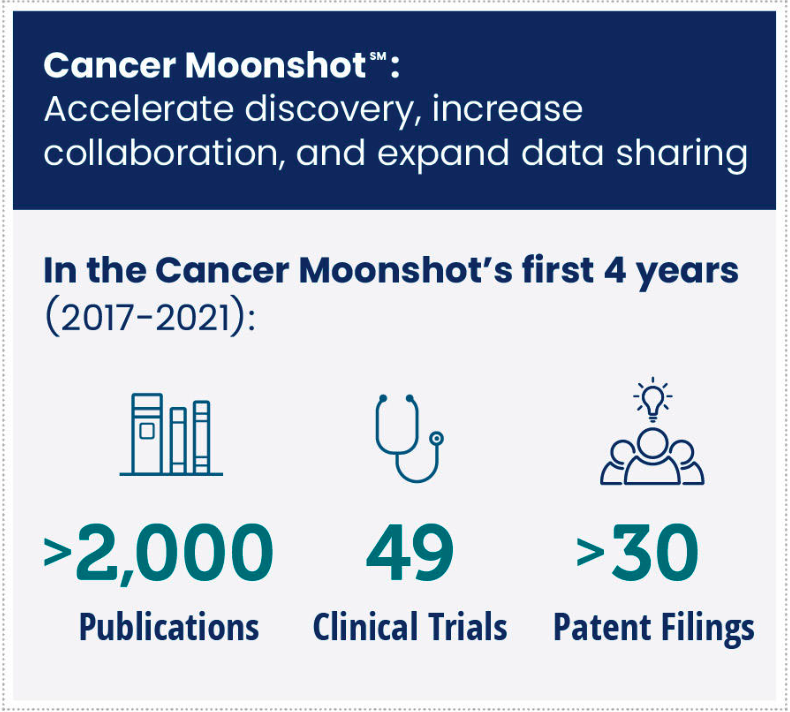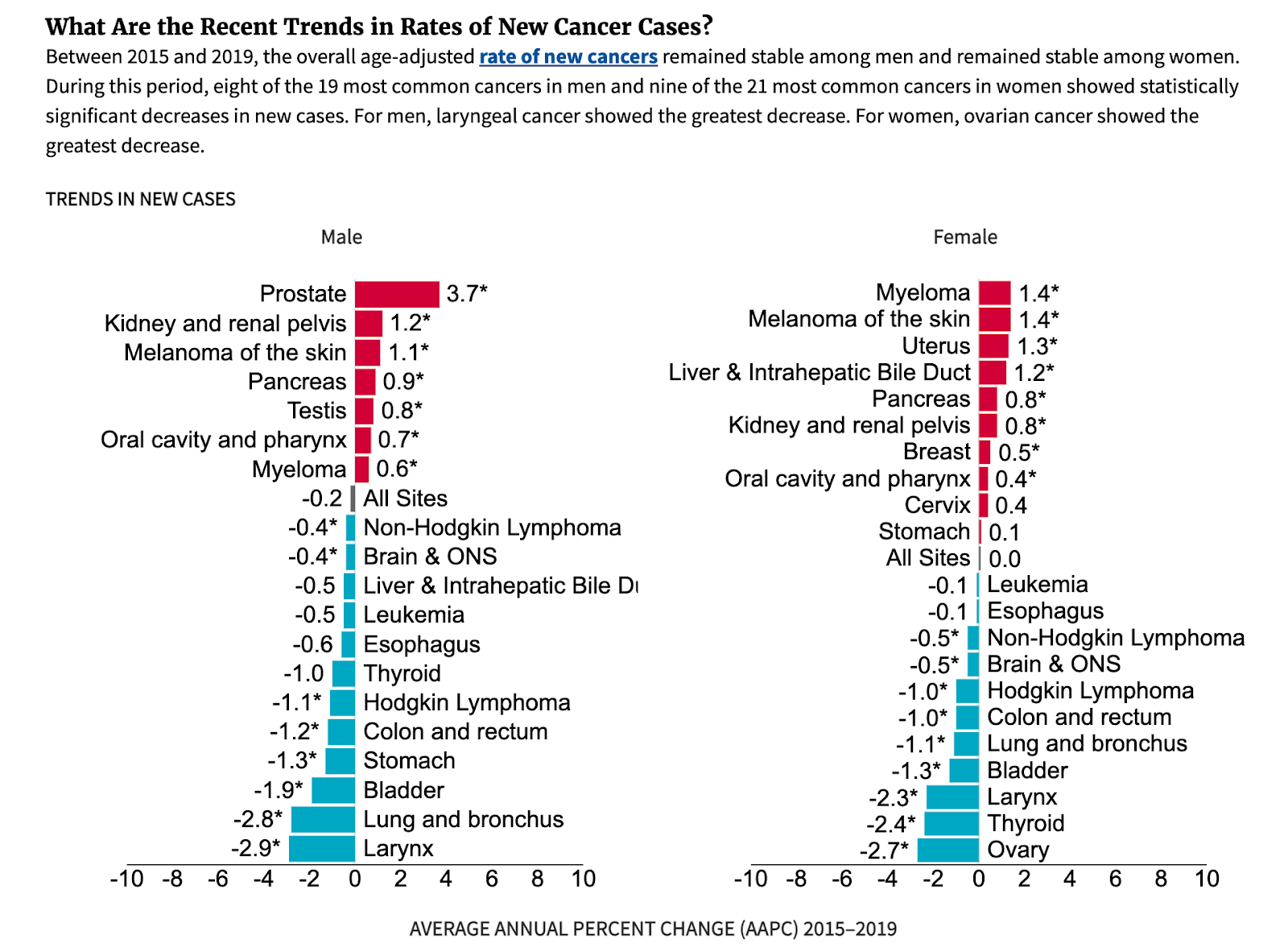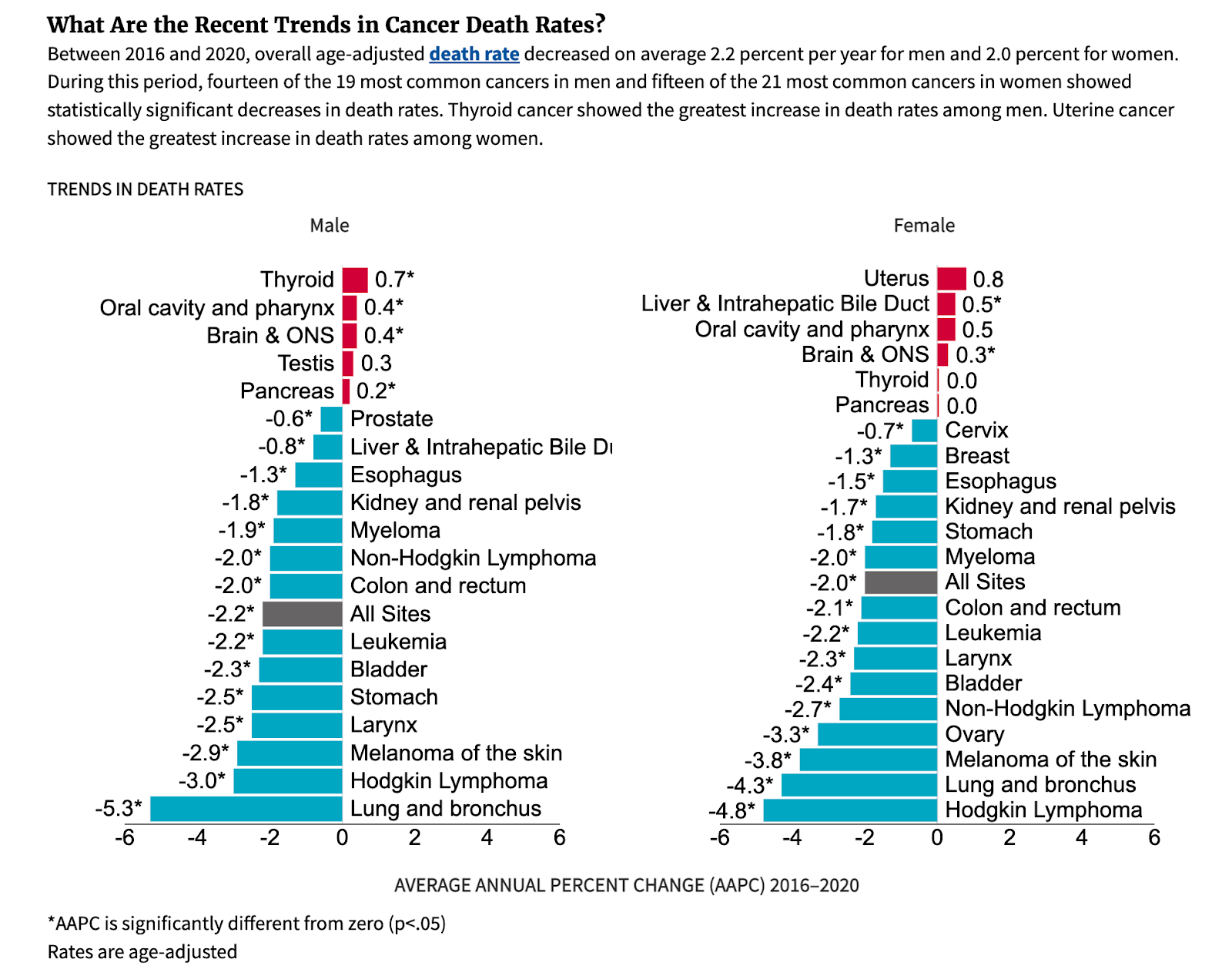
The Morning Meeting with Al Tompkins is a daily Poynter briefing of story ideas worth considering and more timely context for journalists, written by senior faculty Al Tompkins. Sign up here to have it delivered to your inbox every weekday morning.
President Joe Biden has used the phrase “cancer moonshot” since before 2016, when he was vice president. He mentioned it again during his 2023 State of the Union speech. The big dream is to cure cancer in an effort that rivals the American effort to get to the moon in the 1960s. The moonshot effort has not taken off with the fever of the space program, but Biden reignited it after he took office as president.
Biden’s stated goal is to “reduce the death rate from cancer by at least 50 percent over the next 25 years and improve the experience of people and their families living with and surviving cancer— and, by doing this and more, end cancer as we know it today.”

(CDC)
The National Cancer Institute claims a lot of progress is being made thanks to the moonshot program:
Since the Cancer Moonshot was launched in 2016, remarkable progress and notable scientific accomplishments have been made. To date, NCI has supported over 70 programs and consortia and more than 250 research projects. That investment has led to many important insights tied to the Moonshot’s key research priorities.
Here are some of the areas that the moonshot is involved in if you want to explore deeper:
- Improving Immunotherapy
- Advancing Childhood Cancer Research
- Mapping Tumors
- Expanding Cancer Prevention and Early Detection
- Engaging with Patients
- Addressing Drug Resistance
- Collecting and Sharing Cancer Data
- Collaboration and Outreach

(National Cancer Institute)
The cancer trends are not all good news. While some cancer cases are decreasing, some are increasing. But the survival rates of most cancers are mostly getting better, according to the Centers for Disease Control and Prevention.

(National Cancer Institute)

(National Cancer Institute)
The president’s new goals include:
To diagnose cancer sooner — Today, we know cancer as a disease we often diagnose too late. We must increase access to existing ways to screen for cancer, and support patients through the process of diagnosis. We can also greatly expand the cancers we can screen for. Five years ago, detecting many cancers at once through blood tests was a dream. Now new technologies and rigorous clinical trials could put this within our reach. Detecting and diagnosing cancers earlier means there may be more effective treatment options.
To prevent cancer — Today, we know cancer as a disease we have few good ways to prevent. But now, scientists are asking if mRNA technology, used in the safe and effective COVID-19 vaccines to teach your body to fight off the virus, could be used to stop cancer cells when they first appear. And we know we can address environmental exposures to cancer, including by cleaning up polluted sites and delivering clean water to American homes, for example, through the Bipartisan Infrastructure Law.
To address inequities — Today, we know cancer as a disease for which there are stark inequities in access to cancer screening, diagnostics and treatment across race, gender, region, and resources. We can ensure that every community in America – rural, urban, Tribal, and everywhere else – has access to cutting-edge cancer diagnostics, therapeutics, and clinical trials.
To target the right treatments to the right patients — Today, we know cancer as a disease for which we understand too little about why treatments work for some patients, but not for others. We are learning more about how to use information about genetics, immune responses, and other factors to tell which combinations of treatments are likely to work best in an individual patient.
To speed progress against the most deadly and rare cancers, including childhood cancers — Today, we know cancer as a disease for which we lack good strategies for developing treatments against many of the more than 200 distinct types. We can invest in a robust pipeline for new treatments, and the COVID-19 pandemic response has demonstrated we can accelerate clinical trials without compromising safety and effectiveness.
To support patients, caregivers, and survivors — Today, we know cancer as a disease in which we do not do enough to help people and families navigate cancer and its aftermath. We can help people overcome the medical, financial, and emotional burdens that cancer brings by providing support to navigate cancer diagnosis, treatment, and survivorship.
To learn from all patients — Today, we know cancer as a disease in which we don’t learn from the experiences of most patients. We can turn our cancer care system into a learning system. When asked, most people with cancer are glad to make their data available for research to help future patients, if it can be done easily while respecting their privacy. Additionally, the diverse personal experiences of patients and their families make their input essential in developing approaches to end cancer as we know it.
It seems to me that this is a good time for journalists to contact local cancer researchers to find out what they are working on, what they think of the moonshot’s goals and whether there is enough support behind them. Put faces on these goals. I also wonder whether some cancers get more funding than others … and why.
The White House says 9.5 million cancer screening appointments were missed during COVID-19. How difficult is it for clinicians to make up that many missed appointments, and how did all of that early screening affect the severity of cases that screenings detected once appointments got back on schedule?
CDC survey: Most Americans support banning all tobacco products
Discussions of cancer prevention always include some mention of tobacco.
Poll results on support for policies to prohibit tobacco were just published in the journal Preventing Chronic Disease. They included responses from 6,455 American adults. The CDC says the results show:
Overall, 62.3% of adults supported a policy prohibiting the sale of menthol cigarettes, and 57.3% supported a policy prohibiting the sale of all tobacco products. A majority of adults supported tobacco retail policies aimed at preventing initiation, promoting quitting, and reducing tobacco-related disparities. These findings can help inform federal, state, and local efforts to prohibit the sale of tobacco products, including menthol cigarettes.
I don’t know about you, but I was surprised that most Americans would support a total ban on tobacco products, so I wanted to see what the pollsters asked. The methodology page said:
Respondents were asked 1) “To what extent would you support a policy to prohibit the sale of menthol cigarettes?” and 2) “To what extent would you support a policy to prohibit the sale of all tobacco products?” Response options were “strongly support,” “somewhat support,” “somewhat oppose,” and “strongly oppose.” Adults who responded strongly support or somewhat support were considered to support such a policy, and adults who responded strongly oppose or somewhat oppose were considered to oppose such a policy.
The Food and Drug Administration is still considering a ban on menthol tobacco products which, the FDA says, have special appeal to younger people.
Apple Watches causing chaos for 911 operators in ski country
The New York Times explains a problem in the Apple Watch technology that is supposed to help the wearer in an emergency:
As of September, these devices have come equipped with technology meant to detect car crashes and alert 911 dispatchers. It is a more sensitive upgrade to software on Apple devices, now several years old, that can detect when a user falls and then dial for help. But the latest innovation appears to send the device into overdrive: It keeps mistaking skiers, and some other fitness enthusiasts, for car-wreck victims.
Lately, emergency call centers in some ski regions have been inundated with inadvertent, automated calls, dozens or more a week. Phone operators often must put other calls, including real emergencies, on hold to clarify whether the latest siren has been prompted by a human at risk or an overzealous device.
Minnesota Public Radio said snowmobilers have also set off the alarms. MPR reports:
The technology has even triggered false calls from people riding roller coasters.
Brandon Silgjord, director of St. Louis County 911 who oversees the county’s emergency management division, said they even got a false call from someone wearing an Apple watch recently while shoveling snow.
“So, we don’t know whether it was the motion of throwing snow or what happened that triggered a crash event or a fall event, that triggered that 911 call to us,” he said.
Apple says it is “optimizing” the software and, for the moment, reminds wearers that when the watch detects a crash it sends a buzz and warns the wearer it is about to make a call.
Here is some excellent journalism — watch the 2022 duPont-Columbia Award winners
The main reason I have served on many national award juries over the years is that it provides a front-seat view of some of the most remarkable journalism from around the country and world.
I especially enjoyed judging the duPont-Columbia Awards because it often surfaces work that was not only investigative, but sometimes included entries that showed dogged determination to keep chewing away on an important and seemingly unsexy topic.
Those awards were just announced. Watch the finalists here.
A special congratulations to local winning stations KARE-11, WXIA, WBRZ, WTVF and KXAS. It is remarkable how many of those stations have been winners and finalists year after year, in some cases decade after decade. I notice that four of the 10 finalist stations are TEGNA stations and two are NBC owned and operated stations. Now, do yourself a favor and look at the whole list of finalists.






